| The following article is from the Winter, 1992 issue of the Snow Lion Newsletter and is for historical reference only. You can see this in context of the original newsletter here. |

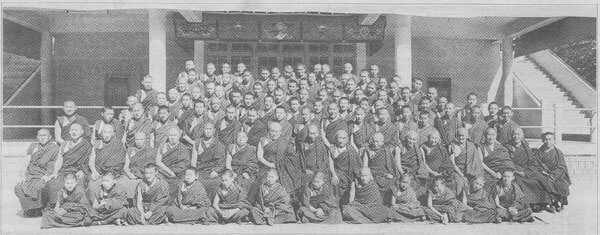
Monks of Namgyal Monastery in Dharamsala.
Institute of Buddhist Studies
Ithaca, New York
Namgyal Monastery is establishing a branch monastery in the United States, in Ithaca, New York, under the direction of His Holiness the Dalai Lama and the parent monastery in Dharamsala, India. Six Namgyal monks, including a Geshe and others with the Master of Sutra and Tantra degree, have been selected to establish the Namgyal Monastery Institute of Buddhist Studies and will arrive in Ithaca in late spring of 1992.
In addition to carrying out their usual monastic routines, the Ithaca resident Tibetan monks will administer a structured program of study of sutra and tantra for Western students. Students wishing to pursue authentic study of Tibetan Buddhist philosophy can apply for admission to the Monastery 's Institute of Buddhist Studies. The Institute will offer a five-year degree program based on Namgyal's unique curriculum, which will include classical and colloquial Tibetan language, the study of logic, debate, the Buddhist tenet systems, difficult topics in the higher tenet systems, and tantra. The Institute will seek affiliation with various academic institutions to allow students from those universities and colleges to register for classes and receive credit from their primary school. In addition to the degree program, the monks will teach Tibetan arts such as painting, sculpture and mask making as well as courses in Buddhism for non-degree students.
HISTORY OF NAMGYAL MONASTERY
In 1575 Sonam Gyatso, the Third Dalai Lama, founded a monastery, later to be known as Namgyal Dratsang (Victorious Monastery). Since its inception, the monastery has assisted the Dalai Lamas in their public religious activities and performed ritual prayer ceremonies for the welfare of Tibet. From the beginning, the monastery has been a center of learning, contemplation and meditation on the vast and profound Buddhist treatises.
The Dalai Lamas have always guided the activities of the monastery. The Third Dalai Lama established the ritual of Four-faced Mahakala, adopted from the Sakya tradition. The Fifth Dalai Lama instituted practices from the Nyingma tradition and established new traditions of sacred dance and chanting and established the monastery in the Potala where it remained until 1959. The Seventh Dalai Lama gathered monks and scholars from the three great seats of learning-Sera, Drepung and Ganden-and the two Tantric Colleges and assigned Guhyasamaja, Chakrasamvara, Yamantaka and Kalachakra, the special deity of Namgyal, as the main ritual and meditation practices of the monastery. He placed special emphasis on maintaining the practice of Kalachakra, and in conjunction with Zha-lu masters taught dance. To gain admission to the monastery, a monk had to memorize certain texts and was tested by a senior monk who would judge whether he was capable of being examined in the Dalai Lama's presence. If formally admitted, the monk would have a private audience with the Dalai Lama before commencing his duties. The Seventh Dalai Lama also initiated the mandala rituals and came specifically to examine the work and question the monks and to give explanations of the rituals and practices, which is a custom continued to this day by the present Dalai Lama. The Thirteenth Dalai Lama added the practice of Vajrakilaya to the tradition of the monastery.
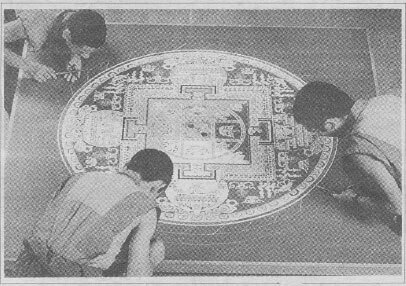
Three Namgyal monks constructing a sand mandala in Ithaca, New York.
NAMGYAL IN EXILE
After the Chinese invasion of Tibet and the 1959 popular uprising, His Holiness the Fourteenth Dalai Lama and one hundred thousand Tibetans fled to India and Nepal, among them 55 monks from Namgyal. Namgyal Monastery was re-established just outside the residence of His Holiness in Dharamsala, India, where the Namgyal traditions are being preserved and continued today.
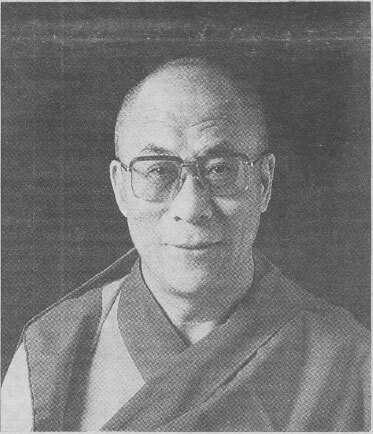
His Holiness the Dalai Lama. Photo: Don Farber/Thubten Dhargye Ling.
Because Namgyal is the private monastery of His Holiness the Dalai Lama, whose monks are called on to assist in his public religious activities, and is also a tantrie college, monks have less personal time and require a more streamlined study program focusing on the essentials of sutra and tantra. For these special requirements, His Holiness the present Dalai Lama has introduced many innovations to the monastery including a new syllabus and program of study. The program is now becoming a model for other Tibetan monasteries. The program takes thirteen years to complete, at which time a Master of Sutra and Tantra degree is bestowed upon those who successfully pass the final examinations. The Namgyal study program is unique in that it combines both sutra and tantra in one degree-granting program.
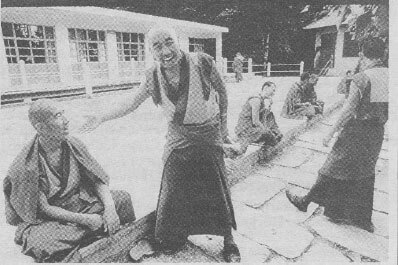
Namgyal monks debating. Photo: Bill Warren.
NAMGYAL ESTABLISHES BRANCH MONASTERY IN AMERICA AND THE INSTITUTE OF BUDDHIST STUDIES
In order to assist Western students who wish to study in an authentic way but are not able to go to India for the necessary length of time, Namgyal Monastery is now establishing a branch monastery in the United States. The Namgyal curriculum has been adapted (same program minus the memorization) to a five-year program for western students wishing to seriously study and practice. His Holiness the Dalai Lama has called the opening of the Ithaca branch monastery and educational program an excellent and important project.
The Namgyal Monastery and Institute of Buddhist Studies (Namgyal Institute) will be located in Ithaca, New York, on the edge of the Cornell University campus. Several spacious buildings are currently under consideration. The monastery is looking to have a large assembly hall and shrine room, monks' quarters, kitchen, classroom areas, a library, and a museum housing a permanent sand mandala, thangkas, masks and statues. Monks affiliated with Namgyal/Ithaca will also be taking courses at Cornell University and various area institutions while they are stationed in Ithaca in order to broaden their own educational background. Several of the Ithaca monks will also be available to travel for the purpose of creating sand mandalas and butter sculptures and give performances of dance and chanting.
STUDY PROGRAM
The basic study program in Tibetan Buddhism of the Namgyal Monastery Institute is a five-year degree program. Students will study Tibetan language and the entire scope of Buddhist sutra and tantra. Classes will be conducted in English, except for the Tibetan language classes, and all textbooks are in English translation. Each year is divided into three semesters-two with emphasis on study and one emphasizing primarily meditation. Exams will be given at the completion of each semester. The last semester of the fifth year will be conducted at Namgyal Monastery in Dharamsala, India with students taking final exams which will include debates with monks of the monastery. Students will be presented with their degree in Buddhist Studies in Dharamsala.
NAMGYAL MONASTERY INSTITUTE OF BUDDHIST STUDIES FACULTY
All of the Namgyal monks associated with the U.S. branch have been specially selected and are well qualified to serve the wide array of western needs. Namgyal Monastery is non-sectarian in that most of the monks have received teachings and initiations from major Tibetan teachers such as H.H. the Dalai Lama, H.H. Kyabje Ling Rinpoche, Kyabje Trijang Rinpoche, the Abbots of Namgyal Dratsang, H.E. Sakya Chogyey Trichen Rinpoche, H.H. Dilgo Khentse Rinpoche, Trulshik Rinpoche and other learned scholars. The basic background of the Namgyal monks is as follows:
- æExtensive study and practice of the Guhyasama'ja, Chakrasamvara, Yamantaka and Kalachakra tantric systems, Mahakala, Yamaraja, Palden Lhamo, etc. and the mandatory Vajrakilaya retreat.
- æThirteen years of Buddhist Philosophy which includes Logic and Epistemology, Critical Philosophy (non-Buddhist and Vaibhashika systems, Sautrantika, Cittamatra and Madhyamika thought), Hermeneutics (linguistic and semantic philosophy) and Tantra. Each subject requires concentrated critical study and memorization which is coordinated with formal debate to invigorate the process of critical inquiry.
At the completion of each of these phases of study, formal oral and written examinations are taken, conducted by the Abbot and senior scholars of Namgyal Monastery and the other major Tibetan monastic colleges. The monks also study the creation of mandalas including sand mandalas, painting, butter sculpture, ritual chanting and music; and also religious dance. Namgyal monks are known for having a broad range of skills.
Monks who successfully complete this entire program are awarded the Namgyal Master of Sutra and Tantra degree.
NAMGYAL INSTITUTE FACULTY MEMBERS
GESHE TENZIN RABGYE
Born 1931, Lhasa, Tibet
Received his Geshe degree from Sera Monastery. The curriculum at Sera was similar to that of other monastic universities. Geshe-la studied the Collected Topics of Valid Cognition, Perfection of Wisdom, Middle Way philosophy, Knowledge and Discipline. Geshe-la's time was divided between personal practice, studying the main texts, receiving explanations from his teachers and debating.
In 1983 he was appointed Teacher of Buddhist Philosophy at Namgyal Monastery by His Holiness the Dalai Lama and has served that post since then.
VEN. PEMA LOSANG CHOGYEN
Born 1957, Nyenkar, Tibet
Entered Namgyal Monastery in 1970 and began his studies in Buddhist philosophy, practice and the arts. In 1986, Ven. Chogyen received the monastery's highest degree, the Master of Sutra and Tantra, in the first division (equivalent of highest honors). Since 1986, he has served as a teacher of mandala and ritual arts, giving textual and analytical as well as artistic instruction. He is fluent in English. Since 1981, Ven. Chogyen has accompanied His Holiness the Dalai Lama on many foreign travels as the leading artist of the monastery.
In 1989-91 he worked on a special project of creating a three-dimensional Vajrabhairava mandala in the virtual space of a mainframe computer, using experimental software at the Cornell University Program for Computer Graphics. Ven. Chogyen is currently a full-time graduate student at Columbia University pursuing a doctoral degree in comparative religion.
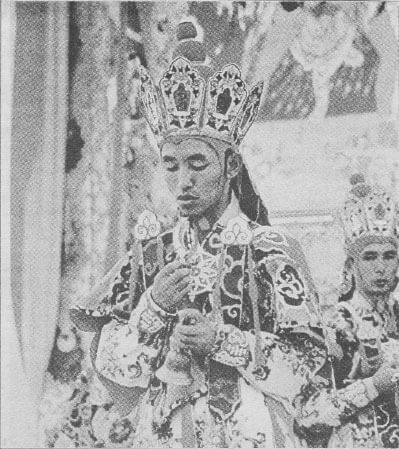
Namgyal monks performing Kalachakra ritual dance. Photo: Bernard Feiten.
In October of 1991, the Namgyal Administrative Committee in Dharamsala appointed Ven. Pema Losang Chogyen to the post of Committee Representative (Acting Director) for establishment of the United States branch of the Namgyal Monastery Institute of Buddhist Studies.
VEN. TSERING NAMGYAL
Born 1956, Dingri, Tibet
Entered Namgyal Monastery in 1969. Studied Buddhist philosophy for 15 years and in 1986 received the degree of Master of Sutra and Tantra. He has specialized in the practices of Guhyasamij ja, Heruka, Yamantaka and Kalachakra. He has also studied mandala construction, ritual dance, monastic music and other religious arts. Ven. Namgyal has traveled as a member of the entourage of His Holiness the XIV Dalai Lama more than fifteen times in India and abroad. During his time as a member of the entourage he has served as a gyaling player, a constructor of sand mandalas and as a performer of the Kalachakra dances, etc. He has also served as instructor of sand mandala construction at the monastery. He is a member of the Namgyal Administrative Board and is fluent in English.
VEN. THUBTEN WANGCHEN
Born 1954, Kyirong, Tibet
Entered Namgyal Monastery in 1970 and began intensive studies on Buddhist philosophy, rites and ritual arts of various meditational deities.
In 1981, he began work at the Nagarjuna Institute in Barcelona, Spain, translating important Buddhist texts and preparing materials presented at several international Buddhist conferences. He accompanied His Holiness the Dalai Lama on many European tours.
In 1989, Ven. Thubten Wangchen became the Director of the Lama Project, a video project sponsored by the Meridian Trust, London. He has taught Tibetan language to individuals and general groups in Spain, has been a guest speaker at many universities and colleges in Europe and has produced numerous television documentaries on Tibetans living in and outside of India.
Ven. Wangchen speaks, reads, and writes fluently in Tibetan, Hindi, English, and Spanish.
VEN. TENZIN LHUNPO
Born 1955, Lhatse, Tibet
Entered Namgyal Monastery in 1969. Studied the liturgy of various meditational deities and invocation rites of protectors. Having passed the oral exams before His Holiness the Dalai Lama, he took on the study of traditional Buddhist sacred arts, including ritual music, buner sculpture, dance and construction of sand mandalas. For thirteen years, from 1974 to 1986, he studied a wide range of Buddhist sciences: logic, epistemology, philosophy, ethics, monastic history and discipline, hermeneutics and esoteric systems (tantra). In 1986, Ven. Lhunpo earned the degree of Master of Sutra and Tantra. Ven. Tenzin Lhunpo is fluent in English.
VEN. DHONDUP GYALTSEN
Born 1947, Gung Thang, Near Lhasa, Tibet
Originally studied at Tashi Lhunpo Monastery. Entered Namgyal Monastery in 1963. Has studied Buddhist Philosophy, tantric meditational practices of Guhyasamaja, Heruka, Yamantaka and Kalachakra. Ven. Gyaltsen has also studied mandala construction, ritual dance, monastic music and butter sculpture.?
*NOTE: Western scholars and other monks will be added to the faculty as the Institute develops. The first two years will necessarily be somewhat experimental as the Institute adjusts to the needs of students.

